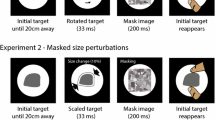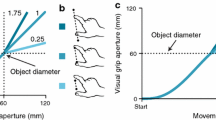Summary
The spatial and temporal organization of hand and eye movements were studied in normal human subjects as they pointed toward small visual targets. The experiment was designed to assess the role of information about target position in correcting the trajectory of the hand when view of the hand was not available. To accomplish this, the duration of target presentation was systematically varied across blocks of trials. The results of this experiment showed that pointing movements were about 3 times more accurate when the target was present throughout the entire pointing movement, than when the target disappeared shortly after the hand movement had begun. These data indicate that pointing movements made without view of the limb are not purely preprogrammed but instead, are corrected during their execution. These modifications to the motor program are smoothly integrated into the ongoing movement and must depend upon comparing visual information about the position of the target with non-visual information about the position of the limb. The source of this non-visual information was not directly established in the present experiment but presumably must be derived from kinesthetic reafferences and/or efference copy.
Similar content being viewed by others
References
Abend W, Bizzi E, Morasso P (1982) Human arm trajectory formation. Brain 105: 331–348
Bartz AE (1962) Eye movement latency, duration and response time as a function of angular displacement. J Exp Psychol 64: 318–324
Beaubaton D, Hay L (1982) Integration of visual cues in rapid goal directed movements. Behav Brain Res 5: 92–93
Becker W, Fuchs AF (1969) Further properties of the human saccadic system: eye movements and correction saccades with and without visual fixation points. Vision Res 9: 1247–1258
Beggs WDA, Howarth CI (1972) The movement of the hand toward a target. Q J Exp Psychol 24: 448–453
Biguer B, Jeannerod M, Prablanc C (1982) The coordination of eye, head and arm movements during reaching at a single visual target. Exp Brain Res 46: 301–304
Carlton LG (1981) Processing visual feedback information for movement control. J Exp Psychol 7: 1019–1030
Conti P, Beaubaton D (1976) Utilisation des informations visuelles dans le contrôle du mouvement: étude de la précision des pointages chez l'homme. Trav Hum 39: 19–32
Crossman ERFW, Goodeve PJ (1963) Feedback control of hand-movement and Fitts' law. Published (1983) Q J Exp Psychol 35A: 251–278
Echallier JF, Pernier J, Prablanc C (1978) Système de pilotage de stimulations et de recueil de paramètres relatifs à des réponses motrices. Int J Bio Med Comput 9: 341–352
Festinger L, Canon LK (1965) Information about spatial location based on knowledge about efference. Psychol Rev 72: 373–384
Fitts PM (1954) The information capacity of the human motor system in controlling the amplitude of movement. J Exp Psychol 47: 381–391
Freund JH, Büdingen HJ (1978) The relationship between speed and amplitude of the fastest voluntary contractions of human arm muscle. Exp Brain Res 31: 1–12
Hansen RM, Skavenski AA (1977) Accuracy of eye position information for motor control. Vision Res 17: 919–926
Keele SW, Posner RMI (1968) Processing of visual feedback in rapid movements. J Exp Psychol 77: 155–158
Klapp ST (1975) Feedback versus motor programming in the control of aimed movements. J Exp Psychol 104: 147–153
Kroon JN, Rijsdijk JP, Van der Wildt GJ (1980) Peripheral contrast sensitivity for sine-wave gratings and single periods. Vision Res 20: 243–252
Mather JA, Fisk JD (1985) Orienting to targets by looking and pointing. I. Parallels and interactions in ocular and manual performance. Q J Exp Psychol 37A: 315–338
Paillard J (1980) The multi channeling of visual cues and the organization of a visually guided response. In: Stelmach GE, Requin J (eds) Tutorials in motor behavior. North-Holland Publishing Co, Amsterdam
Pélisson D, Prablanc C, Goodale MA, Jeannerod M (1986) Visual control of reaching movement without vision of the limb. II. Evidence of fast unconscious processes correcting the trajectory of the hand to the final position of a double-step stimulus. Exp Brain Res 62: 303–311
Prablanc C, Echallier JF, Komilis E, Jeannerod M (1979) Optimal response of eye and hand motor systems in pointing. I. Spatiotemporal characteristics of eye and hand movements and their relationships when varying the amount of visual information. Biol Cybern 35: 113–124
Rabitt P, Rodgers B (1977) What does a man do after he makes an error? An analysis of response programming. Q J Psychol 29: 727–743
Schmidt RA, Zelaznik H, Hawkins B, Frank JS, Quinn JT (1979) Motor-output variability: a theory for the accuracy of rapid motor acts. Psychol Rev 86: 415–451
White CT, Eason C, Barlett NR (1962) Latency and duration of eye movements in the horizontal plane. J Opt Soc Am 52: 210–213
Woodworth RS (1899) The accuracy of voluntary movement. Psychol Rev Monogr Suppl 3: 3
Wright CE, Meyer DE (1983) Conditions for a linear speed-accuracy trade-off in aimed movements. Q J Exp Psychol 35A: 279–296
Zangemeister WH, Stark L (1981) Active head rotations and eyehead coordination. Ann NY Acad Sci 374: 540–559
Author information
Authors and Affiliations
Rights and permissions
About this article
Cite this article
Prablanc, C., Pélisson, D. & Goodale, M.A. Visual control of reaching movements without vision of the limb. Exp Brain Res 62, 293–302 (1986). https://doi.org/10.1007/BF00238848
Received:
Accepted:
Issue Date:
DOI: https://doi.org/10.1007/BF00238848




